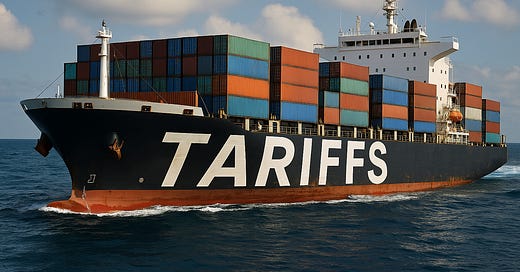What a global trade fight means for biotech
Biotech is already feeling the pinch from tariffs. What happens if pharmaceuticals are next?
Scientific research doesn’t respect borders and neither does the biotech supply chain. But trade policy does. With newly implemented tariffs adding cost and friction to the import of lab equipment, reagents, and other R&D essentials, the industry is already adjusting. So far, finished pharmaceutical products have been left off the list. But that exemption could be temporary, and the consequences of pulling drugs into the scope of these measures could be far more disruptive.
As part of a broader push to reshape American manufacturing, the U.S. has imposed broad new import duties on goods from many major trading partners, including many of the materials and components that biotech and other research-driven industries depend on. For biotech, the impact is clearest in the rising cost around everyday inputs, from raw materials to specialized equipment. These aren’t minor items; they’re foundational to lab work and biomanufacturing.
While large firms may have the resources to absorb or reroute, early-stage biotechs and academic spinouts are already feeling the strain. The market has taken notice. Biotech stocks fell last week as investors began to see trade policy as a longer-term risk.

What do current tariffs mean for biotech and pharma?
The first wave of tariffs doesn’t target pharmaceuticals directly, but it’s already rippling through the infrastructure that supports research, drug discovery and development. From PCR plates, glassware and pipettes to centrifuges and incubators, many of the everyday tools that keep biotech labs running became at least 10% more expensive almost overnight. These components aren’t easily substituted or sourced locally, and in many cases, they’re tied to single suppliers abroad.
The immediate impact has been operational. During the pandemic, global logistics systems nearly broke down, and in many areas, they haven’t fully recovered. Shortages of basics like pipette tips became routine, and some supply chains are still catching up. Now, with tariffs layered on top, costs are rising and timelines are stretching even further.
For early stage biotechs, academic labs, and contract manufacturers, this creates a difficult position: they lack both the bargaining power and the inventory buffers that larger firms rely on to weather disruptions.
As someone who spent the last 7+ years working in the lab, I can attest that many of these materials were already very expensive. Now add rising inflation, tariffs, and shrinking public research budgets to the mix, and you have a damaging combination. One that could directly hinder the pace and quality of scientific work in the United States but also globally.
Some companies may look to stockpile key inputs or reassess where and how they source materials, including exploring domestic alternatives, even if they come at a higher cost. Others, especially smaller firms, might have no choice but to absorb the added expenses and adjust their timelines accordingly. The result is a kind of invisible tax on innovation, which means slower progress, tighter margins, and more friction in an already complex research environment.
And while the tariffs are framed as temporary tools to encourage domestic production, the reality is that U.S. manufacturing capacity for biotech inputs remains limited. Rebuilding or reorienting these supply chains is possible but it won’t happen in a single budget cycle.
What would tariffs on pharmaceuticals mean?
While pharmaceuticals have so far remained exempt from the latest round of tariffs, the industry is not breathing easy. The idea of taxing imported drugs has been brought up before, often framed as a way to encourage domestic manufacturing of essential medicines. In practice, however, adding tariffs to pharmaceuticals could sharply raise drug prices, strain supply chains, and complicate global research and development efforts.
Modern drug production is a global operation. Active pharmaceutical ingredients, intermediates, and even finished medicines often move through multiple countries before reaching patients. Imposing tariffs on any link in that chain would disrupt the system that relies on speed, consistency, and scale.
For generic drugmakers, where profit margins are already thin, even modest tariffs could make some products economically unviable. For branded pharmaceutical firms, tariffs might not threaten viability, but they could force difficult decisions about pricing, market access, and long-term manufacturing strategy. In both cases, patients could ultimately pay the cost, either directly through higher prices or indirectly through reduced availability and insurance premiums.
There’s also the issue of preparedness. Some larger firms are already expanding their U.S. manufacturing, in part to hedge against future policy shifts. But building out domestic pharmaceutical capacity is expensive, time-consuming, and subject to regulatory hurdles. For smaller companies, particularly those without deep pockets or regulatory experience, onshoring is not a realistic short term option.
For now, pharmaceutical tariffs remain a policy possibility, not a reality. But in an environment where economic nationalism is gaining ground, the industry is right to take the threat seriously. In a sector where stability is critical, even the talk of tariffs can cause waves.
Do tariffs bring any benefits?
Supporters of pharmaceutical tariffs argue that they could strengthen domestic manufacturing capacity for critical drugs, making the U.S. less dependent on foreign suppliers, particularly in times of geopolitical tension or global health crises. In theory, tariffs could help incentivize companies to invest in U.S. based facilities, create jobs, and reduce vulnerabilities in the supply chain.
There’s also a national security angle. Covid underscored how fragile medical supply chains can be. For some policymakers, onshoring production of key medications isn’t just economic policy, but it’s about preparedness. Tariffs, they argue, are a lever to accelerate that shift.
But those benefits depend on significant parallel investment in infrastructure, regulatory capacity, workforce development, and incentives that go beyond blunt trade measures. Without that broader strategy, tariffs may simply raise costs without delivering resilience.
Biotech and pharma have long depended on open global networks to power research, manufacture medicines, and move innovation from bench to bedside. Tariffs, while politically appealing, introduce a new layer of strain into that system, affecting not just the cost of doing business, but the pace of scientific progress.
For now, the impact is concentrated in the lab infrastructure that underpins discovery. But if pharmaceutical products themselves are pulled into the tariff framework, the consequences could reach much further - into pricing, access, and long-term competitiveness.
Tariffs risk becoming less a lever of industrial policy than a tax on innovation, one paid not just by companies, but by patients and researchers alike.
If you’ve got thoughts or questions, please drop them in the comments.
Thanks for subscribing to Biotech Blueprint!
DISCLAIMER: This content is for informational purposes only. It should not be taken as legal, tax, investment, financial, or other advice. The views expressed here are my own and do not reflect the opinions of any company or institution.
DISCLOSURE: I have no business relationships with any company mentioned in this article.






Would tariffs on lab equipment help onshore preclinical drug discovery or do you think more of it will be offshored to China and India as a result of tariffs?
For people interested in the economics of Pharma manufacturing, Brad Setser is worth following on “X”, while the Brookings Institute had a detailed analysis out in the past week. You need some carrot to go with the stick in the form of lower corporate taxes to act as an inducement to reshore (which will take years).